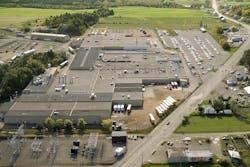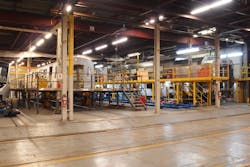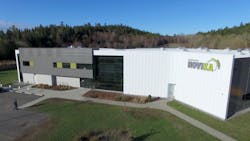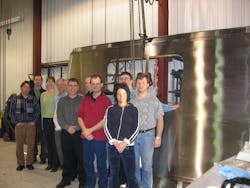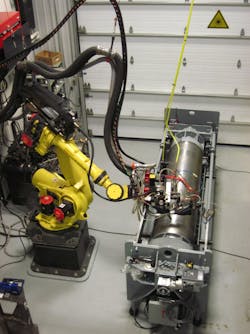Laser welding reduces complexity, time, and cost of railcar manufacturing
LORRAINE BLAIS
Since 1974, Bombardier Transportation (Berlin, Germany) has been manufacturing railcars in its La Pocatière (Quebec, Canada) plant. Since its first contract to manufacture Montreal’s subway cars in 1974, Bombardier has manufactured more than 7000 railway passenger vehicles for transportation companies and corporations in Canada, the U.S., and overseas (FIGURE 1).
Within Bombardier Transportation’s global organization, the La Pocatière plant team are experts in welding processes, manufacturing methods, and development of specialized tools. Leveraging the team’s inventiveness and ability to integrate advanced processes within its production activities, the plant hosts Bombardier’s North American welding center and has the highest level of robotization within the group (FIGURE 2).Novika’s role in laser welding
In 2005, the aesthetic quality and high production speeds of laser welding aroused Bombardier’s interest, prompting the company to ask that Novika carry out a technology watch on the subject. Novika quickly recognized that laser welding could bring significant benefits to many manufacturing sectors.
“The performance of laser welding spoke for itself. There were too many benefits in term of quality and productivity to close our eyes on this technology,” said Lorraine Blais, manager – laser processing at Novika. “No matter what Bombardier decided, we would offer R&D and transfer services in laser welding. We knew that would imply a substantial effort to infobut we were willing to do that if it was necessary to bring laser welding to Canadian manufacturers,” Blais concluded.
Already familiar with low-power lasers, the Novika research center decided to proceed with the implementation of its own laser laboratory, starting with the acquisition of a 3 kW IPG Photonics (Oxford, MA) fiber laser source—the first in Canada at that time. Within a few months, the team was working on the development of this laboratory and of a new service offer to manufacturing companies. With a strong foundation in physics, thermodynamics, automation, and optics, Novika only needed to add resources in metallurgy to meet industrial needs.
Early laboratory work focused on autogenous (joining two or more metals without the addition of filler metal) welding of stainless steel for Bombardier Transportation. In November 2006, one month after starting its lab, Novika delivered a laser-welded train sidewall section following a new design developed by Bombardier. Thanks to close collaboration between the two organizations, the challenge was met within the required timeframe and budget (FIGURE 4).This demonstration assembly proved the aesthetic and productivity gains related to the integration of laser welding into Bombardier’s manufacturing activities. Several other prototypes followed to evaluate the redesign possibilities of different subassemblies, taking advantage of the new process. Presented with these new opportunities, Bombardier decided to invest in its La Pocatière plant to implement the laser processes.
Following this decision, Novika continued the feasibility assessments for various assemblies, produced many prototypes, and gave training to more than 200 employees on topics related to laser welding.
Bombardier’s team needed to acquire new knowledge of laser equipment use and maintenance, design practices for laser welding, and laser safety management skills. “Our goal as a technology transfer center is to empower our customers to use and adapt the processes we develop. We do not want to keep them attached to us for the slightest change: if our work is well done, the customer themselves can adapt the processes to keep them in line with their needs,” says Blais. “There is no doubt that such an approach carries with it the risk of losing customers. But in fact, it helps build a relationship of trust and they come back regularly to explore new topics with us.”
Installation of laboratory and production cell
Bombardier relied on the expertise of Kuka Schweissenlagen (Irxleben, Germany) for the development and implementation of its laser-based production cell commissioned in 2009. Measuring 30 m long, it is equipped with a 5 kW IPG fiber laser that also feeds—via two 100 m optical fibers—a development laboratory located in a remote sector of the plant. The eight loading stations with self-guided vehicles help to reduce non-productive times whereas Precitec’s (Gaggenau, Germany) online monitoring system tracks the quality and integrity of welds.
While Novika collaborated in the qualification of the process, Bombardier’s team was actively involved in the design and implementation. These experienced engineers and technicians quickly mastered the technology and started adapting the process and the equipment. Shortly after, laser-welded production was launched with more-than-satisfactory results.
Subsequent joint work
Far from bringing the Bombardier/Novika collaboration to an end, the introduction of laser welding in production sparked several new joint projects. Various weld configurations were developed, and the technical challenges associated with sensitive combinations addressed, maintaining a continuous transfer of information from one organization to the other.
Novika also developed a hybrid laser/gas-metal-arc-welding (GMAW) process for Bombardier tailored for structural railcar assemblies. The process uses the Servo-Robot Adaptive Platform to automatically adjust GMAW and laser welding parameters.
To effectively support Bombardier in this new challenge, Novika had previously acquired a 15 kW fiber laser source and a Lincoln Electric (Cleveland, OH) PowerWave 655R welder. To allow the hybrid welding of pronounced curves, Novika produced a variant of the process using two robots—the path of the second robot being automatically generated from information coming from the first robot. This process is now patented by Bombardier. Prototypes of different subassemblies were developed with an iterative production process and constant concern for manufacturability.
Cold-wire aluminum laser welding, laser welding under local confinement, and laser straightening projects have since succeeded one another, thanks to the constant commitment of both partners and the support of Canadian research funding organizations such as the Natural Sciences and Engineering Research Council of Canada (NSERC; Ottawa, ON, Canada). In accordance with Novika’s policies, Bombardier owns all railway-related IP developed in these projects and can thus disseminate innovations to its other plants.
The impact of laser welding
Since 2009, more than 20,000 major subassemblies were laser-welded at the La Pocatière plant, with previously unmatched aesthetic quality and productivity. By fully integrating the process, Bombardier can introduce continuous improvements to welding equipment and procedures and adapt its products to laser welding in order to reduce welding hours, the number of parts, and tooling costs (FIGURE 5).Novika now has a versatile laser laboratory, adding laser surface treatment processes to its service offering, including continuous-wave (CW), pulsed, and ultrashort-pulsed laser sources. By building on the expertise developed over the years, Novika has been able to assist more than 70 companies of all sizes in their journey to laser processing. Its strong expertise in hybrid laser/GMAW welding also allowed Novika to win important contracts from the Canadian Nuclear Waste Management Organization (NWMO; Toronto, ON, Canada) for the closure welding of irradiated waste containers (FIGURE 6).
LORRAINE BLAIS ([email protected]) is VP and head of the Laser Processing Department at Novika Solutions, La Pocatière, QC, Canada; www.novika.ca.
